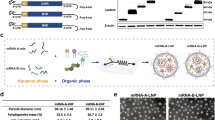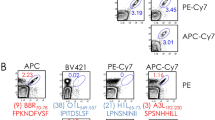Abstract
Vaccination with live vaccinia virus affords long-lasting protection against variola virus, the agent of smallpox. Its mode of protection in humans, however, has not been clearly defined. Here we report that vaccinia-specific B-cell responses are essential for protection of macaques from monkeypox virus, a variola virus ortholog. Antibody-mediated depletion of B cells, but not CD4+ or CD8+ T cells, abrogated vaccine-induced protection from a lethal intravenous challenge with monkeypox virus. In addition, passive transfer of human vaccinia-neutralizing antibodies protected nonimmunized macaques from severe disease. Thus, vaccines able to induce long-lasting protective antibody responses may constitute realistic alternatives to the currently available smallpox vaccine (Dryvax).
This is a preview of subscription content, access via your institution
Access options
Subscribe to this journal
Receive 12 print issues and online access
$209.00 per year
only $17.42 per issue
Buy this article
- Purchase on Springer Link
- Instant access to full article PDF
Prices may be subject to local taxes which are calculated during checkout



Similar content being viewed by others
Accession codes
References
Bray, M. & Buller, M. Looking back at smallpox. Clin. Infect. Dis. 38, 882–889 (2004).
Fenner, F., Henderson, D.A., Arita, I., Jezek, Z. & Ladnyi, I. Smallpox and its eradication (World Health Organization, Geneva, 1988).
Bray, M. & Wright, M.E. Progressive vaccinia. Clin. Infect. Dis. 36, 766–774 (2003).
Kemper, A.R., Davis, M.M. & Freed, G.L. Expected adverse events in a mass smallpox vaccination campaign. Eff. Clin. Pract. 5, 84–90 (2002).
Henderson, D.A. et al. Smallpox as a biological weapon: medical and public health management. Working Group on Civilian Biodefense. J. Am. Med. Assoc. 281, 2127–2137 (1999).
Earl, P.L. et al. Immunogenicity of a highly attenuated MVA smallpox vaccine and protection against monkeypox. Nature 428, 182–185 (2004).
Hooper, J.W. et al. Smallpox DNA vaccine protects nonhuman primates against lethal monkeypox. J. Virol. 78, 4433–4443 (2004).
Weltzin, R. et al. Clonal vaccinia virus grown in cell culture as a new smallpox vaccine. Nat. Med. 9, 1125–1130 (2003).
Zaucha, G.M., Jahrling, P.B., Geisbert, T.W., Swearengen, J.R. & Hensley, L. The pathology of experimental aerosolized monkeypox virus infection in cynomolgus monkeys (Macaca fascicularis). Lab. Invest. 81, 1581–1600 (2001).
Edghill-Smith, Y. et al. Modeling a safer smallpox vaccination regimen, for human immunodeficiency virus type 1-infected patients, in immunocompromised macaques. J. Infect. Dis. 188, 1181–1191 (2003).
Schmitz, J.E. et al. A nonhuman primate model for the selective elimination of CD8+ lymphocytes using a mouse-human chimeric monoclonal antibody. Am. J. Pathol. 154, 1923–1932 (1999).
Reff, M.E. et al. Depletion of B cells in vivo by a chimeric mouse human monoclonal antibody to CD20. Blood 83, 435–445 (1994).
Schmitz, J.E. et al. Effect of humoral immune responses on controlling viremia during primary infection of rhesus monkeys with simian immunodeficiency virus. J. Virol. 77, 2165–2173 (2003).
Manischewitz, J. et al. Development of a novel vaccinia-neutralization assay based on reporter-gene expression. J. Infect. Dis. 188, 440–448 (2003).
Kulesh, D.A. et al. Smallpox and pan-orthopox virus detection by real-time 3′-minor groove binder TaqMan assays on the Roche LightCycler and the Cepheid Smart Cycler platforms. J. Clin. Microbiol. 42, 601–609 (2004).
Mourad, G.J. et al. Humanized IgG1 and IgG4 anti-CD4 monoclonal antibodies: effects on lymphocytes in the blood, lymph nodes, and renal allografts in cynomolgus monkeys. Transplantation 65, 632–641 (1998).
Mack, T.M., Noble, J., Jr & Thomas, D.B. A prospective study of serum antibody and protection against smallpox. Am. J. Trop. Med. Hyg. 21, 214–218 (1972).
Sarkar, J.K., Mitra, A.C. & Mukherjee, M.K. The minimum protective level of antibodies in smallpox. Bull. World Health Organ. 52, 307–311 (1975).
Edghill-Smith, Y. et al. Smallpox vaccine does not protect macaques with AIDS from a lethal monkeypox virus challenge. J. Infect. Dis. 191, 372–381 (2005).
Wyatt, L.S., Earl, P.L., Eller, L.A. & Moss, B. Highly attenuated smallpox vaccine protects mice with and without immune deficiencies against pathogenic vaccinia virus challenge. Proc. Natl Acad. Sci. USA 101, 4590–4595 (2004).
Belyakov, I.M. et al. Shared modes of protection against poxvirus infection by attenuated and conventional smallpox vaccine viruses. Proc. Natl Acad. Sci. USA 100, 9458–9463 (2003).
Salk, J. & Salk, D. Control of influenza and poliomyelitis with killed virus vaccines. Science 195, 834–847 (1977).
Duncan, S.A. & Smith, G.L. Identification and characterization of an extracellular envelope glycoprotein affecting vaccinia virus egress. J. Virol. 66, 1610–1621 (1992).
Engelstad, M., Howard, S.T. & Smith, G.L. A constitutively expressed vaccinia gene encodes a 42-kDa glycoprotein related to complement control factors that forms part of the extracellular virus envelope. Virology 188, 801–810 (1992).
Hirt, P., Hiller, G. & Wittek, R. Localization and fine structure of a vaccinia virus gene encoding an envelope antigen. J. Virol. 58, 757–764 (1986).
Isaacs, S.N., Wolffe, E.J., Payne, L.G. & Moss, B. Characterization of a vaccinia virus-encoded 42-kilodalton class I membrane glycoprotein component of the extracellular virus envelope. J. Virol. 66, 7217–7224 (1992).
Roper, R.L., Payne, L.G. & Moss, B. Extracellular vaccinia virus envelope glycoprotein encoded by the A33R gene. J. Virol. 70, 3753–3762 (1996).
Centers for Disease Control and Prevention. Multistate outbreak of monkeypox–Illinois, Indiana, and Wisconsin, 2003. Morb. Mortal. Wkly. Rep. 52, 537–540 (2003).
Centers for Disease Control and Prevention. Update: multistate outbreak of monkeypox–Illinois, Indiana, Kansas, Missouri, Ohio, and Wisconsin, 2003. Morb. Mortal. Wkly. Rep. 52, 642–646 (2003).
Ladnyi, I.D., Ziegler, P. & Kima, E. A human infection caused by monkey pox virus in Basankusu Territory, Democratic Republic of the Congo. Bull. World Health Organ. 55, 613–623 (1972).
Marennikova, S.S. et al. Monkey pox in humans: current results. Acta Virol. 33, 246–253 (1989).
Tartaglia, J. et al. NYVAC: a highly attenuated strain of vaccinia virus. Virology 188, 217–232 (1992).
Moss, B. et al. Host range restricted, non-replicating vaccinia virus vectors as vaccine candidates. Adv. Exp. Med. Biol. 397, 7–13 (1996).
Hooper, J.W., Custer, D.M. & Thompson, E. Four-gene-combination DNA vaccine protects mice against a lethal vaccinia virus challenge and elicits appropriate antibody responses in nonhuman primates. Virology 306, 181–195 (2003).
Chakrabarti, S., Sisler, J.R. & Moss, B. Compact, synthetic, vaccinia virus early/late promoter for protein expression. Biotechniques 23, 1094–1097 (1997).
Acknowledgements
Thanks to S. Snodgrass for editorial assistance; M. Zanetti, B. Murphy and M. Martin for critical review of the manuscript; S. Gurunathan and B. Golding for helpful discussion; MedImmune, Centocor and Johnson & Johnson for providing access to monoclonal antibodies; T. Unangst, A. Cristillo, J. Bassler and V. Livingston for flow cytometry; S. Sloane for monkeypox DNA PCRs; E. Thompson for immunoprecipitation assays; and P. Markham, S. Orndorff, J. Treece, J. Parrish, J. Wells and P. Silvera for assistance with the animals. We also are very grateful to P. Jahrling and J. Huggins for providing the stock of the Zaire 79 strain. Reagents used in this study were provided by the US National Institutes of Health Nonhuman Primate Reagent Resource (RR016001, AI040101) and produced by the National Cell Culture Center.
Author information
Authors and Affiliations
Corresponding author
Ethics declarations
Competing interests
The authors declare no competing financial interests.
Rights and permissions
About this article
Cite this article
Edghill-Smith, Y., Golding, H., Manischewitz, J. et al. Smallpox vaccine–induced antibodies are necessary and sufficient for protection against monkeypox virus. Nat Med 11, 740–747 (2005). https://doi.org/10.1038/nm1261
Received:
Accepted:
Published:
Issue Date:
DOI: https://doi.org/10.1038/nm1261
This article is cited by
-
Cross-reactive immune responses to monkeypox virus induced by MVA vaccination in mice
Virology Journal (2023)
-
Monkeypox virus quadrivalent mRNA vaccine induces immune response and protects against vaccinia virus
Signal Transduction and Targeted Therapy (2023)
-
Mpox (formerly monkeypox): pathogenesis, prevention, and treatment
Signal Transduction and Targeted Therapy (2023)
-
Campylobacter vaccination reduces diarrheal disease and infant growth stunting among rhesus macaques
Nature Communications (2023)
-
Mpox: a review of laboratory detection techniques
Archives of Virology (2023)



